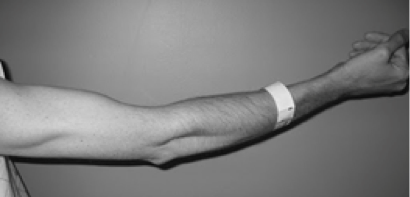With the potential to affect many systems of the body, Marfan syndrome is evaluated by a systemic score, a selective array of features taken from the revised Ghent nosology discussed in last week's Friday Fact.
Disclaimer: none of these signs in isolation confirm a diagnosis of Marfan syndrome, examination and review by a specialist doctor is necessary.

Wrist and Thumb sign (3 points for both signs, 1 point for either)
Easiest described with a photo! This sign is easy to test and can be done by anyone. Do the thumb and little finger overlap when wrapped round the wrist? Does the first joint of the thumb protrude when the thumb is wrapped in the hand?

Pectus Carinatum (2 points) Pectus Excavatum or chest asymmetry (1 point)
These signs can be seen in the general population too but if they are present your doctor should be considering other signs of Marfan syndrome to rule out the connective tissue disorder or refer for more tests.

Hindfoot deformity (2 points) Plain Pes Planus (1 point)
Hindfoot issues, particularly ‘hindfoot valgus’, an outward tilt of the hindfoot (the back of the foot). These problems with the heel and ankle can lead to instability, altered weight distribution and discomfort when walking.
Planus (flat foot) scores fewer points because this is commonly found in the general population so it is less specific. In the case the arch of the foot collapses and the foot flattens and tilts inwards.

Scoliosis or kyphosis (1 point)
These terms refer to curvature of the spine and are another feature that doctors will look for when considering a diagnosis of Marfan syndrome.
Kyphosis is a curvature that makes the spine more rounded and can make a person appear hunched over.
Scoliosis describes a twisting or curvature of the spine to the side.

Reduced Elbow Extension (1 point)
A less specific sign for Marfan syndrome is reduced elbow extension. The arm cannot be outstretched in a flat position, a bend will remain.

Skin Striae (Stretch marks) (1 point)
Stretch marks on the skin are seen as significant and score a point within the systemic score if they are found in uncommon locations and not associated with weight loss/gain or pregnancy. These locations would include mid or lower back, upper arms.

Facial Features (1 point if 3/5 features present)
There are lots of complex medical terms that describe some of the facial features that may be present in Marfan syndrome.
- Dolichocephaly - longer thinner head from front to back
- Downward slanting palpebral fissures - the outside corner of the eye slants downwards in relation to the inner corner of the eye
- Enophtalmos - the eyes are sunken deeply into the eye socket
- Malar hypoplasia - flattened or underdeveloped cheekbones
- Retrognathia - lower jaw is set further back than the upper jaw









